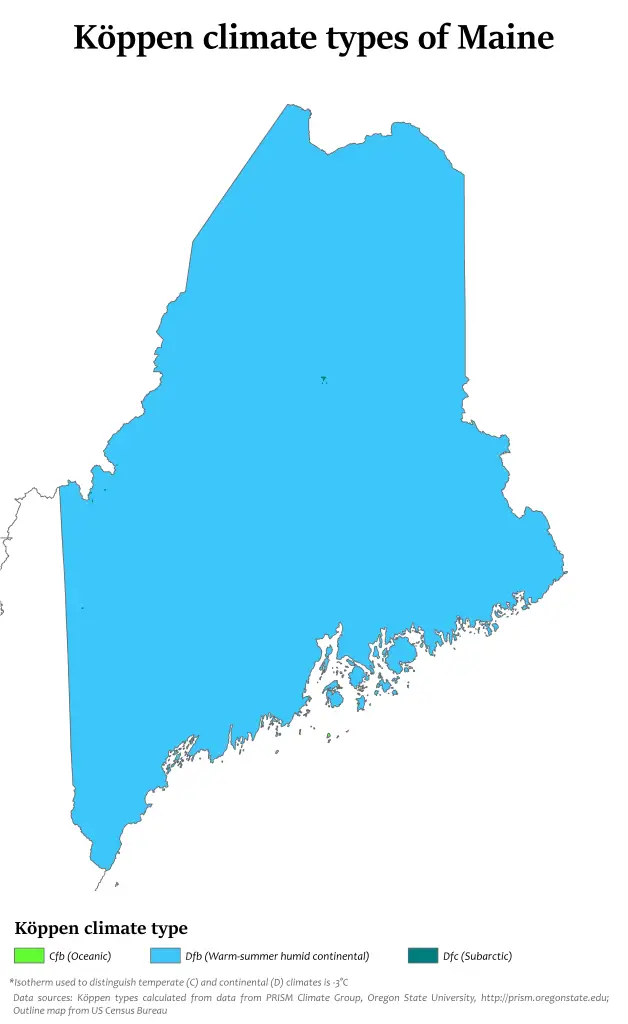Maine Plant Hardiness Zones
| USDA Hardiness Zone | Average Minimum Extreme Winter Temperature Range Fahrenheit (°F) Celsius (°C) | Average Last Frost Date Range In Spring (Beginning Of The Growing Season) | Average First Frost Date Range In Autumn (End Of The Growing Season) |
|---|---|---|---|
| 3b | -35°F to -30°F -37.2°C to -34.4°C | Mid to late May | Mid to late September |
| 4a | -30°F to -25°F -34.4°C to -31.7°C | Mid to late May | Mid to late September |
| 4b | -25°F to -20°F -31.7°C to -28.9°C | Mid to late May | Mid to late September |
| 5a | -20°F to -15°F -28.9°C to -26.1°C | Early to mid-May | Late September to early October |
| 5b | -15°F to -10°F -26.1°C to – 23.3°C | Early to mid-May | Late September to early October |
| 6a | -10°F to -5°F -23.3°C to 20.6°C | Late April to early May | Early to mid-October |
| 6b | -5°F to 0°F -20.6°C to 17.8°C | Late April to early May | Early to mid-October |
| 7a | 0°F to 5°F -17.8°C to -15°C | Late April to early May | Early to mid-October |
Maine Growing Conditions
General Climate

Maine has a humid continental climate and three climate zones: The northern portion, the southern interior, and the coastal climate. Each section experiences different types of weather based on wind direction and location relative to the coast.
The northern portion of the state is affected by wind coming from the west and north. This brings in cold, long winters with lots of snow. The summers are generally mild, and don’t often see extreme heat.
The southern interior experiences hot summers and is influenced by the south and west winds. As the climate warms, Maine experiences longer and longer dry seasons. This extreme weather has been causing forest fires in the state, seeing 900 in 2020.
The coastal region in Maine has a maritime climate. This portion of the state is affected by the Atlantic Ocean and moderates the extremes of the summers and winters in Maine.
The entire state of Maine experiences long, cold winters. The western and northern parts of the state see the most snowfall, receiving up to 100 inches of snow annually. The rest of the state sees between 40 and 80 inches of snow a year, depending on your proximity to the coast.
Microclimates
USDA plant hardiness zones are an important starting point for your garden, but you’ll also need to consider microclimates.
Microclimates are areas where specific conditions create a climate different from the climate they’re situated in.
Buildings, fences, paved areas, or short hills and valleys can create these microclimates.
They can be as small as a space in your backyard or as large as a city.
In other words, learn about your local conditions from local experts to see if your garden falls into a microclimate.
Extreme Weather
Extreme Drought
Due to the warming climate, Maine has been experiencing longer and more frequent periods of drought (most commonly in the southern Interior). Prolonged dry periods and extreme heat can negatively affect the garden if not prepared for. Watering will have to remain at a minimum, depending on the severity of the drought.
Xeriscaping is a water conservation method when designing a garden. This form of gardening includes smart watering techniques like mulching, adding organic matter to the soil, and more. This method also involves choosing hardy, drought-tolerant plants that can withstand the heat.
Nor’easters
Nor’easters are common in Maine from fall through into spring. They are defined as cold coastal storms that bring in lots of snow, sleet, and freezing rain. They can have tremendous winds and can cause flooding and major damage to your property and garden. They affect the coastal areas of Maine and can be really nasty!
Having a heated greenhouse is a splendid way to beat the cold, harsh winds of the Nor’easter storm fronts. A heated greenhouse provides growing opportunities all year round. These are especially good if you’re an avid grower.
Flooding
Climate warming affects Maine in more ways than heat. Due to its location within the higher mid-latitudes, the amount of annual precipitation from winter through spring is projected to increase in this state. The rate of extreme weather events is also said to increase, creating a risk of flash floods.
Flash floods cause runoff, which can bring pollutants into water sources. This can be detrimental to the health and quality of the water. Planting veggies, herbs, and flowers in raised wooden boxes can help with drainage and keep the plant roots dry.
Growing Season
Maine experiences long, cold winters, shortening the growing season, which lasts between 134 and 157 days a year. The season typically begins around April to May and ends anytime from September to October. Depending on your location, the growing season can be mild.
Plant cold-hardy veggies that don’t love too much heat for areas that deal with a prolonged winter. Examples include radish, lettuce, and kale. The southern interior should look towards heat-loving veggies during this short but hot growing season, with the anticipation for hotter, dryer summers. This includes plants like tomatoes, eggplant, and cucumbers.
Maine Gardening Tips

Do Off-Season Projects
Because Maine experiences long, cold winters, gardens are dormant for a large portion of the year. Just because the weather outside isn’t hands-in-the-dirt permitted, it doesn’t mean there aren’t valuable garden-related activities you can’t do this time of year.
Prepare your garden for spring by using the winter months to clean and sharpen tools, take inventory of your seeds, order more if needed, and plan and map out your growing area. By taking the necessary steps in the off-season, you can get a head start once the weather starts to warm.
Understand Acidic Soils
The majority of Maine’s soil profile is slightly on the acidic side. The soil type is called Spodosols and is typically found in the eastern Gulf states. This can affect growing as some plants don’t do well in higher acidity. Knowing what plants prefer this type of soil and the companion plants to help them thrive is an advantageous way to grow in Maine.
Some examples of plants that prefer more acidic soil and grow well together are blueberries, lilac, thyme, parsley, and basil. Rhododendrons and azaleas also prefer slightly acidic soils. For veggies, try radishes, sweet potatoes, and broccoli.
Consult With Local Professionals
Consulting with local gardening professionals allows you to benefit from their experience with your area’s conditions, the plants that do well there, and overall best practices.
Maine Plant Suggestions

Trees
- Shagbark Hickory (Carya ovata)
- Sassafras (Sassafras albidum)
- Striped Maple (Acer pensylvamicum)
Shrubs
- Northern Spicebush (Lindera benzoin)
- Rhododendron Rhodora (Rhododendron canadense)
- Arrowwood Viburnum ( Viburnum dentatum)
Flowers
- Red columbine (Aquilegia canadensis)
- Violet (Violaceae)
- Blue Wood Aster (Symphyotrichum cordifolium)
Vegetables
- Beauregard Sweet Potato (Ipomoea batatas)
- Radish (Raphanus sativus)
- Broccoli (Brassica oleracea var. italica)
Herbs
- Thyme (Thymus vulgaris L.)
- Sage (Salvia officinalis)
- Lavender (Lavandula)
Spices
- Wild Chervil (Cryptotaenia canadensis)
- Parsley (Petroselinum crispum)
- Basil (Ocimum basilicum)
Fruits
- Blueberry Northern Highbush (Vaccinium corymbosum)
- Beach Plum (Prunus maritimus)
- Wild Strawberry (Fragaria virginiana)
Succulents
- Eastern Prickly Pear (Opuntia humifusa)
- Hens and Chicks (Sempervivum spp.)
- Sedum (Sedum acre)
Disclaimer
Any of the above can change and is not exhaustive.
Treat anything above like a good starter guide. Then use that as a foundation as you consult with local gardeners, professionals, forecasts, guides, and organizations.

